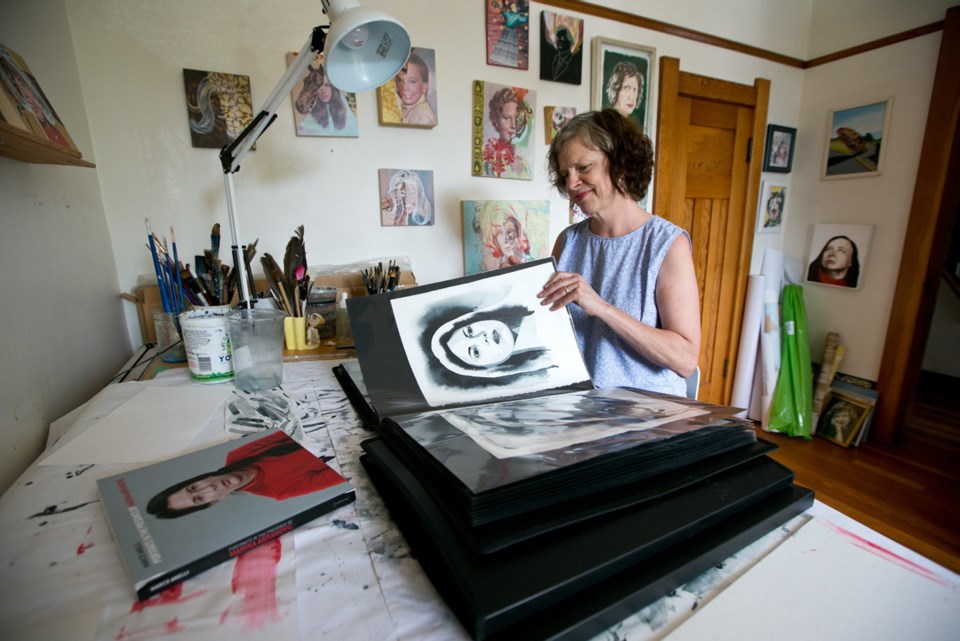After she painted a dozen portraits in 12 days, Betty-Ann Lampman felt justifiably proud of herself.
By the time she had completed 50 in 50 days, the Victoria artist had tapped into something like a marathoner’s high.
“I barely looked at what I was producing anymore. Must … keep … going,” Lampman wrote on her blog.
Finally, in mid-July, the artist achieved her goal: 100 portraits in 100 days. Lampman’s black-and-white ink paintings (see the images at balampman.ca) are compelling, remarkable and surprisingly varied.
She’ll unveil her series, 100 Days, in October with an exhibition at the Martin Batchelor Gallery. She has also booked shows at galleries in Toronto and Montreal.
Her inspiration was Marina Abramovic’s famous performance-art project The Artist is Present (2010). For this, Abramovic sat silently in a chair at New York’s Museum of Modern Art six days a week, seven hours a day, for a total of 736 hours.
During this time, different audience members took turns sitting in a chair, facing her across a table, looking into Abramovic’s eyes.
People were fascinated by this unorthodox project, especially when Abramovic’s former lover and collaborator, Ulay, took the chair for a tear-filled reunion that went viral.
The Artist is Present drew international headlines. Already renowned in the field (some call her “the grandmother of performance art”) Abramovic emerged a superstar.
What inspired Lampman even more directly were photographs of the sitters taken by Marco Anelli. He compiled these in his 2012 book Portraits in the Presence of Marina Abramovic.
Lampman’s paintings are taken directly from these photographs.
Anelli has seen reproductions of her series (Lampman tipped him on her project) and likes them.
The Italian photographer wrote the Times Colonist: “I was really impressed ... Betty-Ann’s paintings give all the faces a new interpretation in black and white while keeping precisely every single aspect and peculiarity.”
Anelli says he intends to put a link to Lampman’s website on his own. And he plans to tell Abramovic, who’s a friend, about her project.
So what drew Lampman to Anelli’s photographs?
“I like faces. I’ve always liked painting faces. I’ve always liked taking photos of faces,” said the artist.
The idea of 100 artworks in 100 days comes from something called The 100 Day Project. Hatched by art instructor Michael Bierut at Yale University, the idea is that art students create one of the same thing for 100 consecutive days.
Bierut’s students did things such as photographing themselves with strangers or finding new uses for a wooden chair.
But Lampman’s project, creating 100 ink portraits over 100 days (each took three or four hours to create), is much more ambitious.
Her light-filled home studio is stuffed with supplies, curios and artworks. Some are collages Lampman made — strange half-horse-headed/half-humanoid creatures.
Lampman is married to David P. Smith, a songwriter-accordionist who specializes in raw reconstructions (and deconstructions) of country and blues.
She studied art at Concordia University, graduating with distinction. Lampman has shown in various exhibitions over the years (Open Space, Rogue Gallery, Nanaimo Art Gallery) and had one solo exhibition at Polychrome.
While she has had some success, Lampman’s art practice often took a backseat to family and making a living. Her husband is a house-painter by day; she does the books. Lampman’s a busy mom. And she tends to her mother, who’s in a care home.
Lampman publicized 100 Days widely on social media: Facebook, Instagram, Pinterest, Twitter. She has had plenty of support and interest. One of her subjects, a young, blond man who’s a “designer or something” in New York City, emailed to see if he could buy Lampman’s portrait of him. Not yet — the artist wants to have full exhibitions of her series first.
Surprisingly given the quality of her work, Lampman says she hasn’t painted much since completing her degree in 1989.
And she had never painted with acrylic ink before, something that requires its own technique.
“It was hard to get past the rusty part — you go to do it and think: ‘Oh God, I’m so crappy now.’ I pushed past that,” she said.
Not surprisingly, the entire exercise — requiring dedication, energy, discipline, skill — boosted her confidence.
“Probably in art school I didn’t focus on things as much as this. Every day. This is crazy, it took over my life,” Lampman said.
“I guess it kind of showed me what I could do.”
